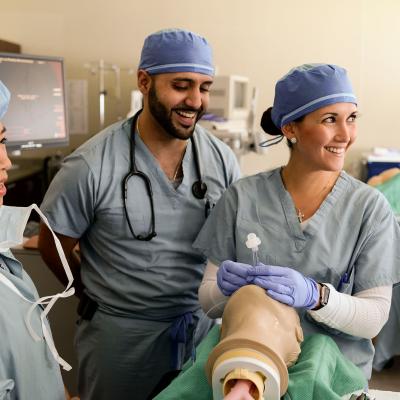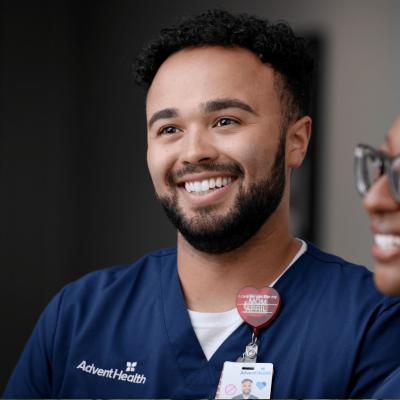- AdventHealth University

Nursing roles have changed drastically over time due to a rapid succession of discoveries and innovations. [1] While many forces have converged to alter the contemporary nursing practice, few changes have had as intense an impact as technology.
In such a fast-paced environment, planning can prove challenging, especially in the nursing field. In the midst of this change, nursing professionals must consider how new developments transform caregiving. With this in mind, the following six tools have made a considerable impact regarding how nurses care for patients.
Electronic IV Monitors
The US Food and Drug Administration (FDA) has approved the ivWatch as a tool that nurses can use to monitor intravenous (IV) pediatric patients. [2] The device continuously monitors IV lines for leaks that might occur outside of a patient’s vein and into connecting tissue. For now, the FDA has authorized care providers to use the device on patients under the age of 17.
The ivWatch uses a noninvasive sensor that emits an infrared light to detect changes in skin tissue. It then sends a message to a nurse station, for example, so that care providers can intervene immediately to reduce patient harm. ivWatch CEO Gary Warren states that his firm eventually intends to make the device available for IV patients of all ages and mitigate a treatment risk that affects all consumers that require IV fluids and medicines.
The Sphygmomanometer
Nurses and other care providers use the sphygmomanometer to take blood pressure readings. [3] The device consists of the familiar rubber cuff that wraps around the arms and sends pressure to a mercury dial or digital readout.
The sphygmomanometer allows nurses to measure systolic and diastolic blood pressure easily. Systolic pressure refers to the contraction of the heart ventricles when blood pulses from the heart and into the body, while the diastolic pressure is a measure of the resting period when the ventricles expand to accept more blood. When the heart beats, blood pressure rises to the systolic level, and then drops to the diastolic level.
When using the manual, mercury device, nurses wrap the cuff just above the bend in the arm and place a stethoscope against the patient’s skin over an artery. The nurses then release the air, observing systolic pressure with the first sound and diastolic pressure as the vein emits a dribbling sound.
Electronic Health Records
Electronic health records (EHRs) have significantly and positively impacted service delivery. [1] Physicians and nurses can easily access EHRs where and when needed. Care providers can use the technology to amalgamate patient information that derives from many sources such as:
- Community health agencies
- Health clinics
- Hospitals
- Other care providers
Former President George Bush established the goal for all Americans to have electronic health records by 2004. Former President Barack Obama further supported this goal by offering $30 million in stimulus funds to encourage healthcare organizations to adopt the technology. Today, legislators have come close to making EHRs a requisite information tool. Furthermore, some laws also require that care providers make meaningful use of electronic health records in a way that promotes community wellness.
Portable Defibrillator
In the United States, cardiac arrests take the lives of over 350,000 consumers annually. An automated external defibrillator (AED) is a medical device that analyzes the heart rhythm and, if necessary, delivers a jolt of electricity to reestablish effective heart activity. [4] The American Red Cross supports the notion that training and fast access to AEDs for all United States citizens can save 50,000 lives every year. On average, emergency responders take eight to twelve minutes to respond to a 911 call, with the chances of survival falling by 10 percent for each minute that a consumer waits for assistance.
Automated external defibrillators are the only devices proven effective for reestablishing a heartbeat. The devices have proven so effective that lawmakers enacted the Federal Cardiac Arrest Survival Act of 2000 to limit liability actions taken against AED rescuers and equipment providers.
Sonogram/ Ultrasound
Care providers use ultrasound equipment to capture diagnostic images of the interior of human anatomies. [5] The procedure requires little preparation. Imaging specialists use different kinds of ultrasound equipment for varying diagnoses. Medical professionals might order ultrasound images as a safe way to diagnose several conditions such as:
- Heart damage
- Infection
- Pain
- Pregnancy
- Swelling
An ultrasound, or sonogram, is a noninvasive diagnostic test that uses sound waves to generate images of the interior of the body. The device emits the high frequency sound waves through a probe that care providers place against gel they have layered on the patient’s skin, and a transducer collects the sounds then forwards them to a computer that translates the data into images. Early versions of the device generate flat, two-dimensional images, while newer models display 3D images that specialists can manipulate as needed.
Drug Delivery Implants
Today’s sophisticated medical interventions might require the delivery of pharmaceuticals over an extended period. [6] For example, doctors have used drug delivery implants to deliver contraceptives for some time. These devices remain in the body and deliver a steady, time-released flow of medicine.
Now, scientists are exploring drug delivery implants for other uses, such as pain relief and mental health treatments. This alternative delivery method could prove especially beneficial for pediatric patients, ensuring proper use and eliminating the possibility of accidental overdoses. Furthermore, drug delivery implants can eliminate theft and intentional drug abuse. One promising prospect for the technology is the complete elimination of pain.
Medical innovations improve community well-being and care provider performance. [7] In addition, new health technology increases patient safety and treatment efficiency. As technological innovations continue to emerge, care providers will find more time to deliver direct patient care.
Learn More
Adventist University started building its solid foundation for nursing education in 1908 when it began training nurses so healthcare could be provided for more people. Today they offer cutting edge education and experienced faculty dedicated to helping individuals interested in pursuing a bachelor of science in nursing degree.
Sources:
[1] http://nursingworld.org/MainMenuCategories/ANAMarketplace/ANAPeriodicals/OJIN/TableofContents/Vol-18-2013/No2-May-2013/Impact-of-Emerging-Technology.html
[2] http://patientmonitoring.medicaldevices-business-review.com/news/ivwatch-model-400-device-gets-fda-approval-to-monitor-iv-therapy-in-pediatric-patients-090117-5711682
[3] https://www.britannica.com/technology/sphygmomanometer
[4] http://www.redcross.org/prepare/location/workplace/easy-as-aed
[5] https://www.radiologyinfo.org/en/info.cfm?pg=genus
[6] https://www.extremetech.com/extreme/239841-drug-delivery-implants-change-way-approach-chronic-conditions
[7] http://www.sparling.com/SparAdmin/arts/DAR%20Nursing%202012%20New%20Tech%200512.pdf


